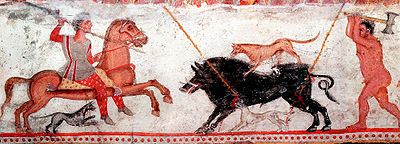
Thracian tomb of Aleksandrovo kurgan
Encyclopedia

Thracia
Thracia is a Web-Based computer game created and developed by an exclusively Romanian team, part of Infotrend Consulting, and launched in 2009. At the time, it was the first endeavor of its kind. All browser games were text based, made up mostly of static content...
n burial mound and tomb
Tomb
A tomb is a repository for the remains of the dead. It is generally any structurally enclosed interment space or burial chamber, of varying sizes...
excavated near Aleksandrovo
Aleksandrovo
Alexandrovo or Aleksandrovo may refer to:*Alexandrovo, name of several rural localities in Russia*Alexandrovo air base, an air base near Ryazan, Russia...
, Haskovo Province
Haskovo Province
Haskovo Province is a province in southern Bulgaria, neighbouring Greece and Turkey to the southeast, comprising parts of the Thracian valley along the river Maritsa. It is named after its administrative and industrial centre - the city of Haskovo...
, South-Eastern Bulgaria
Bulgaria
Bulgaria , officially the Republic of Bulgaria , is a parliamentary democracy within a unitary constitutional republic in Southeast Europe. The country borders Romania to the north, Serbia and Macedonia to the west, Greece and Turkey to the south, as well as the Black Sea to the east...
, dated to c. 4th century BCE.
On December 17, 2000 the tomb was accidentally uncovered by an earth-moving machine. Looters subsequently entered the tomb, damaging some of its frescoes. In 2001 Bulgarian archaeologist Georgi Kitov
Georgi Kitov
Georgi Kitov was a Bulgarian archaeologist and thracologist with controversial methods. He specialized in Thracian archaeology.-Finding the Thracian tomb:...
led a rescue excavation of the tomb, discovering a round chamber of about 3 metres (9.8 ft) in diameter, accessible through a small antechamber and a tunnel, approximately 6 metres (19.7 ft) long. Both the antechamber and main chamber are decorated with well-preserved fresco
Fresco
Fresco is any of several related mural painting types, executed on plaster on walls or ceilings. The word fresco comes from the Greek word affresca which derives from the Latin word for "fresh". Frescoes first developed in the ancient world and continued to be popular through the Renaissance...
es that reflect the artist's knowledge of Late Classical
Classical Greece
Classical Greece was a 200 year period in Greek culture lasting from the 5th through 4th centuries BC. This classical period had a powerful influence on the Roman Empire and greatly influenced the foundation of Western civilizations. Much of modern Western politics, artistic thought, such as...
and Early Hellenistic art. The fresco in the main chamber depicts a hunting scene where a boar is attacked by a mounted hunter and a naked man wielding a double-axe. The double-axe is interpreted as representing royal power, the naked man as representing Zalmoxis
Zalmoxis
Zalmoxis , is a divinity of the Getae, mentioned by Herodotus in his Histories IV, 93-96...
, the Thracian solar god corresponding to Zeus
Zeus
In the ancient Greek religion, Zeus was the "Father of Gods and men" who ruled the Olympians of Mount Olympus as a father ruled the family. He was the god of sky and thunder in Greek mythology. His Roman counterpart is Jupiter and his Etruscan counterpart is Tinia.Zeus was the child of Cronus...
.
A graffito
Graffito (archaeology)
A Graffito , in an archaeological context, is a deliberate mark made by scratching or engraving on a large surface such as a wall. The marks may form an image or writing...
in the chamber inscribed with the Thracian name Kozemases indicates either the tomb's noble patron or its artist.
The Thracian tomb of Alexandrovo is dated at early 4th century BC. Wall paintings exhibit the change in appearance due to Greek
Greece
Greece , officially the Hellenic Republic , and historically Hellas or the Republic of Greece in English, is a country in southeastern Europe....
influence. In the wall-paintings beards, tattoos, cloaks, boots, hats, top-knots have disappeared. Greek footwear replaces their boots.
The tomb may be that of Triballi
Triballi
The Triballi were an ancient tribe whose dominion was around the plains of southern modern Serbia and west Bulgaria, at the Angrus and Brongus and the Iskur River, roughly centered where Serbia and Bulgaria are joined....
.
Also other changes are seen such as Thracians wearing gold or bronze torcs around their necks (usually three).

